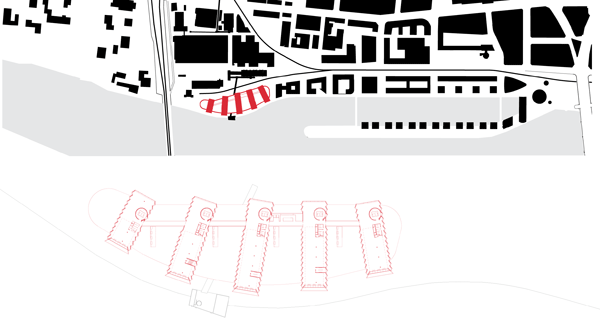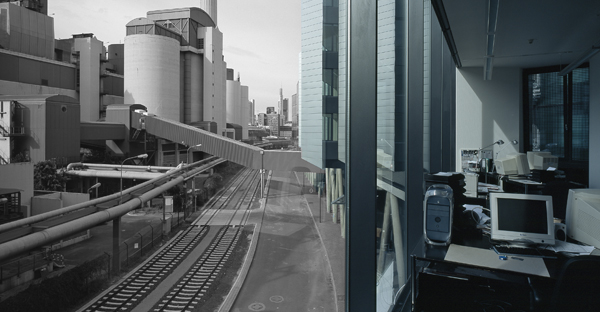
On the edge – Bürowelten zwischen Kraftwerk und Wasserfront
Der Pier ist Teil eines neuen Stadtquartiers am Westhafen in Frankfurt am Main, welches mit seiner angestrebten Mischnutzung auch zur Stärkung der Innenstadt beitragen soll. In diesem Sinne kann auch das zu integrierende bestehende Kohlekraftwerk als funktionale Erweiterung gesehen werden. Entwurfsbestimmend für die Kombination aus Bürohäusern und Parkgarage war daher das industriell geprägte Umfeld.
Der Main bildet die südliche Begrenzung des Piers und sein Ufer wird vor allem von der Bedarfsinfrastruktur des nördlich gelegenen Kraftwerks eingenommen. Deshalb verläuft auch das Förderband für die Belieferung mit Kohle mitten durch das Gebäude und bestimmt die Höhe des Sockels, der auf drei Geschossen Parkflächen, Läden und Gastronomie beherbergt. Die eigentliche Büronutzung findet in fünf einzelnen Baukörpern ihren Platz, welche auf diesem Sockel aufliegen und sich zum Fluss hin öffnen. Die gefaltete Fassade und die Terrassen zwischen den Baukörpern geben immer wieder durch große Panoramafenster spektakuläre Ausblicke auf die Flusslandschaft frei.
Auch in der Materialität folgt die Fassade aus eloxiertem Aluminium dem industriellen Umfeld, zugleich wird aber auch ein lebendiges Lichtspiel erzeugt, welches auf die neue Nutzung des Areals verweist. Durch die technische Ästhetik wird die vermeintlich „hässliche“ Umgebung also nicht verleugnet, sondern die funktionale Schönheit des Ortes betont. So erscheint auch die ihrer ursprünglichen Funktion nur scheinbar enthobene Versorgungsleitung wie eine Brücke vom Industrie- ins Kommunikationszeitalter.
On the edge – Office bridge between power station and waterfront
The Westhafen Pier is a new type of synthesis of office buildings with an above-ground parking structure and is located directly in front of the existing coal power station. The design was strongly influenced by the site's industrial surroundings. On its eastern side – the site of the former Westhafen – lies the newly built Westhafen quarter with offices and housing. On its western side lies the Main-Neckar Bridge with heavy train traffic.
The river Main forms the quarter’s southern perimeter, it provides supply infrastructure for the power station to the north of the site. The coal supply line from the river drives straight through the building, and determines the height of the building’s “plinth”; a base formed by a three-storey unit with garage showrooms and restaurants. On top of this plinth are five four-storey buildings arranged like an open hand, fanning out towards the river. The supply line acts as a bridge thrown out from the heavy industrial function and aesthetic to the shining elegance of the new buildings moored to it.
The zig-zag shape of the facades achieves an optimal river view for the inhabitants. Between the building fingers, generous terraces offer great views of the river. The façades are made of anodised aluminium which creates a vivid play of light. Far from denying its “ugly” industrial environment, the smooth, shiny surfaces and technical aesthetic of the pier buildings seem to enhance and highlight the functional beauty of its location. The big panorama windows at the tips of the fingers tie in the industrial past of the location with a view of Frankfurt’s contemporary urban landscape.



